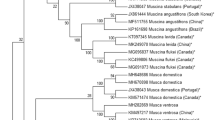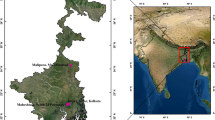Abstract
Precise species identification of every insect sample collected from criminal scenes play an essential role in the accurate estimation of postmortem interval. The morphological similarity poses a great challenge for forensic entomologists. DNA-based method can be used as a supplemental means of morphological method. In the present study, we demonstrate the applicability of the 304-bp cytochrome oxidase I gene fragment in molecular identification of forensically important Diptera. We analyzed 75 specimens belonging to 19 species of 3 families originating from China (Calliphoridae: Chrysomya megacephala, Chrysomya albiceps, Chrysomya rufifacies, Chrysomya nigripes, Aldrichina grahami; Lucilia bazini, Lucilia caesar, Lucilia cuprina, Lucilia sericata, Lucilia porphyrina; Muscidae: Musca autumnalis, Musca domestica, Fannia canicularis, Stomoxys calcitrans; Sarcophagidae: Sarcophaga albiceps, Sarcophaga dux, Helicophagella melanura) and Egypt (Calliphoridae: C. megacephala, C. albiceps, L. sericata; Muscidae: M. domestica, F. canicularis, S. calcitrans, Synthesiomyia nudiseta; Sarcophagidae: Sarcophaga argyrostoma). This region was amplified using polymerase chain reaction followed by direct sequencing of the amplification products. Nucleotide sequence divergences were calculated using the Kimura two-parameter distance model and a neighbor-joining phylogenetic tree generated. Intraspecific variation ranged from 0–0.8 % and interspecific variation occurred between 1–19 %. Although all examined specimens were assigned to the correct species and formed distinct monophyletic clades, the data of the phylogenetic analysis were not completely in accordance with the traditional morphological classification. As both C. nigripes and A. grahami unexpectedly joined with Muscidae and Sarcophagidae groups respectively. Moreover, both Calliphorinae and Luciliinae clades failed to represent Calliphoridae as a separate group. Therefore, although molecular methods are beneficial especially if the available evidence are immature stage or degraded fragments of insect, we suggest using this fragment only in addition to other identification methods.

Similar content being viewed by others
References
Aly SM, Wen J, Cai J, Wang X (2012) Cytochrome oxidase II gene “short fragments” applicability in identification of forensically important insects. Rom J Legal Med 20(3):231–236
Aly SM, Wen J, Wang X (2013a) Identification of forensically important Sarcophagidae (Diptera) based on partial mitochondrial COI and COII genes. Am J Forensic Med Pathol. doi:10.1097/PAF.0b013e31828c390e
Aly SM, Wen J, Wang X, Cai J, Liu Q, Zhong M (2013b) Identification of forensically important arthropods on exposed remains during summer season in northeastern Egypt. J Cent South Univ (Med Sci) 38(1):1–6
Ames C, Turner B, Daniel B (2006) The use of mitochondrial cytochrome oxidase I gene (COI) to differentiate two UK blowfly species—Calliphora vicina and Calliphora vomitoria. Forensic Sci Int 164:179–182
Boehme P, Amendt J, Zehner R (2012) The use of COI barcodes for molecular identification of forensically important fly species in Germany. Parasitol Res 110(6):2325–2332
Byrd JH, Castner JL (2009) Insects of forensic importance. In: Byrd JH, Castner JL (eds) Forensic entomology: the utility of arthropods in legal investigations. CRC Press, Boca Raton, pp 39–127
Cainé L, Corte Real F, Saloña-Bordas MI, de Pancorbo MM, Lima G, Magalhães T, Pinheiro F (2009) DNA typing of Diptera collected from human corpses in Portugal. Forensic Sci Int 184(1–3):e21–e23
Desmyter S, Gosselin M (2009) COI sequence variability between Chrysomyinae of forensic interest. Forensic Sci Int Genet 3(2):89–95
Harvey ML (2005) An alternative for the extraction and storage of DNA from insects in forensic entomology. J Forensic Sci 50(3):627–629
Harvey ML, Dadour IR, Gaudieri S (2003a) Mitochondrial DNA cytochrome oxidase I gene: potential for distinction between immature stages of some forensically important fly species (Diptera) in western Australia. Forensic Sci Int 131(2–3):134–139
Harvey ML, Mansell MW, Villet MH, Dadour IR (2003b) Molecular identification of some forensically important blowflies of southern Africa and Australia. Med Vet Entomol 17(4):363–369
Harvey ML, Gaudieri S, Villet MH, Dadour IR (2008) A global study of forensically significant calliphorids: implications for identification. Forensic Sci Int 177(1):66–76
Hebert PDN, Cywinska A, Ball SL, deWaard JR (2003) Biological identifications through DNA barcodes. Proc Biol Sci 270(1512):313–321
Lu BL, Wu HY (2003) Classification and identification of important medical insects of China. Henan science and technology publishing house, Zhengzhou
Meiklejohn KA, Wallman JF, Dowton M (2011) DNA-based identification of forensically important Australian Sarcophagidae (Diptera). Int J Legal Med 125(1):27–32
Mello Rda S, Borja GE, Queiroz MM (2012) How photoperiods affect the immature development of forensically important blowfly species Chrysomya albiceps (Calliphoridae). Parasitol Res 111(3):1067–1073
Nelson LA, Wallmann JF, Dowton M (2007) Using COI barcodes to identify forensically and medically important blowflies. Med Vet Entomol 21(1):44–52
Nelson LA, Wallman JF, Dowton M (2008) Identification of forensically important Chrysomya (Diptera: Calliphoridae) species using the second ribosomal internal transcribed spacer (ITS2). Forensic Sci Int 177(2–3):238–247
Ngoen-klan R, Moophayak K, Klong-klaew T, Irvine KN, Sukontason KL, Prangkio C, Somboon P, Sukontason K (2011) Do climatic and physical factors affect populations of the blow fly Chrysomya megacephala and house fly Musca domestica? Parasitol Res 109(5):1279–1292
Park SH, Zhang Y, Piao H, Yu DH, Jeong HJ, Yoo GY, Chung U, Jo TH et al (2009) Use of cytochrome c oxidase subunit I (COI) nucleotide sequences for identification of the Korean Luciliinae fly species (Diptera: Calliphoridae) in forensic investigations. J Korean Med Sci 24(6):1058–1063
Reibe S, Schmitz J, Madea B (2009) Molecular identification of forensically important blowfly species (Diptera: Calliphoridae) from Germany. Parasitol Res 106(1):257–261
Shaumar N, Mohammad S (1983) Keys for identification of species of family Sarcophagidae (Diptera) in Egypt. Bull Soc Entomol Egypt 64:121–135
Shaumar NF, Mohamed SK, Shoukry IF (1985) Flies of subfamily Muscinae (Muscidae-Diptera) in Egypt. J Egypt Soc Parasitol 15(2):513–523
Shaumar NF, Mohammad SK, Mohammad SA (1989) Keys for identification of species of Family Calliphoridae (Ditpera) in Egypt. J Egypt Soc Parasitol 19(2):669–681
Siriwattanarungsee S, Sukontason KL, Kuntalue B, Piangjai S, Olson JK, Sukontason K (2005) Morphology of the puparia of the housefly, Musca domestica (Diptera: Muscidae) and blowfly, Chrysomya megacephala (Diptera: Calliphoridae). Parasitol Res 96(3):166–170
Sukontason KL, Piangjai S, Bunchu N, Chaiwong T, Sripakdee D, Boonsriwong W, Vogtsberger RC, Sukontason K (2006) Surface ultrastructure of the puparia of the blow fly, Lucilia cuprina (Diptera: Calliphoridae), and flesh fly, Liosarcophaga dux (Diptera: Sarcophagidae). Parasitol Res 98(5):482–487
Sukontason K, Narongchai P, Kanchai C, Vichairat K, Sribanditmongkol P, Bhoopat T, Kurahashi H, Chockiamsai M et al (2007) Forensic entomology cases in Thailand: a review of cases from 2000 to 2006. Parasitol Res 101(5):1417–1423
Sukontason K, Piangjai S, Siriwattanarungsee S, Sukontason KL (2008) Morphology and developmental rate of blowflies Chrysomya megacephala and Chrysomya rufifacies in Thailand: application in forensic entomology. Parasitol Res 102(6):1207–1216
Sukontason K, Bunchu N, Chaiwong T, Moophayak K, Sukontason KL (2010a) Forensically important flesh fly species in Thailand: morphology and developmental rate. Parasitol Res 106(5):1055–1064
Sukontason K, Sribanditmongkol P, Ngoen-klan R, Klong-klaew T, Moophayak K, Sukontason KL (2010b) Differentiation between Lucilia cuprina and Hemipyrellia ligurriens (Diptera: Calliphoridae) larvae for use in forensic entomology applications. Parasitol Res 106(3):641–646
Tamura K, Dudley J, Nei M, Kumar S (2007) MEGA4: Molecular Evolutionary Genetics Analysis (MEGA) software version 4.0. Mol Biol Evol 24(8):1596–1599
Wallman JF, Donnellan SC (2001) The utility of mitochondrial DNA sequences for the identification of forensically important blowflies (Diptera: Calliphoridae) in southeastern Australia. Forensic Sci Int 120(1–2):60–67
Wallman JF, Leys R, Hogendoorn K (2005) Molecular systematics of Australian carrion-breeding blowflies (Diptera: Calliphoridae) based on mitochondrial DNA. Invert Syst 19:1–15
Wang X, Zhong M, Wen J, Cai J, Jiang H, Liu Y, Aly SM, Xiong F (2012) Molecular characterization and expression pattern of an odorant receptor from the myiasis-causing blowfly, Lucilia sericata (Diptera: Calliphoridae). Parasitol Res 110(2):843–851
Ward RD, Zemlak TS, Innes BH, Last PR, Hebert PDN (2005) DNA barcoding Australia’s fish species. Philos Trans R Soc Lond B 360(1462):1847–1857
Waugh J (2007) DNA barcoding in animal species: progress, potential, and pitfalls. Bioessays 9(2):188–197
Wells JD, Sperling FAH (2001) DNA-based identification of forensically important Chrysomyinae (Diptera: Calliphoridae). Forensic Sci Int 120(1–2):110–115
Wells JD, Wall R, Stevens JR (2007) Phylogenetic analysis of forensically important Lucilia flies based on cytochrome oxidase I sequence: a cautionary tale for forensic species determination. Int J Legal Med 121(3):229–233
Xu WQ, Zha JM (1996) Flies of China. Liaoning Science and Technology Press, Shenyang
Zhang Y, Park SH, Yu DH, Yu GY, Jung HJ, Jo TH, Hwang JJ (2007) Identification blow fly species in Korea by mitochondrial DNA ‘Barcodes’. J Korean Med Sci 31:51–58
Zhang D, Wang QK, Yang YZ, Chen YO, Li K (2013) Sensory organs of the antenna of two Fannia species (Diptera: Fanniidae). Parasitol Res. doi:10.1007/s00436-013-3377-4
Author information
Authors and Affiliations
Corresponding authors
Rights and permissions
About this article
Cite this article
Aly, S.M., Wen, J. Applicability of partial characterization of cytochrome oxidase I in identification of forensically important flies (Diptera) from China and Egypt. Parasitol Res 112, 2667–2674 (2013). https://doi.org/10.1007/s00436-013-3449-5
Received:
Accepted:
Published:
Issue Date:
DOI: https://doi.org/10.1007/s00436-013-3449-5




